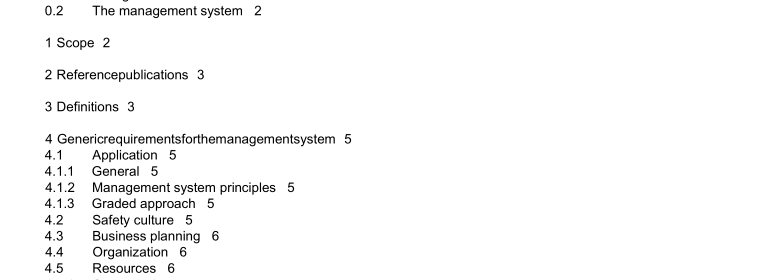CSA N286-12 pdf download – Management system requirements fornu clearfacilities.
This Standard identifies management system requirements for nuclear facilities. It integrates the requirements from management system standards for health, safety, environment, security, economics, and quality. The CSA N-Series of Standards provides an interlinked set of requirements for the management of nuclear facilities. CSA N286 provides overall direction to management to develop and implement sound management practices and controls, while the other CSA nuclear Standards provide technical requirements and guidance that support the management system. CSA N286 is based on a set of 12 principles. The principles are supported by generic requirements (Clause 4). The Standard then presents the specific requirements (Clauses 5 to 9) that are applicable to the life cycle of nuclear facilities. While this edition of CSA N286 was being planned, it was recognized that many of the same management system requirements apply not only to each life-cycle phase of a nuclear facility but also to all aspects of the management of the facility, including health, safety, environment, security, economics, and quality. It was also recognized that life-cycle phase activities may be delegated to suppliers and, therefore, the requirements of this Standard apply to these suppliers. In addition, a graded approach, commensurate with risk, may be defined and used when applying the requirements of this Standard. Before this Standard was drafted, two preparatory activities were undertaken that included an industry scan of applicable reference documents and a condition assessment to determine the impact and value of a management system that integrates the requirements from management system standards for health, safety, environment, security, economics, and quality.
Management— all the activities that are used to coordinate, direct, and control the business. When used as a noun, the term “Management” includes those workers responsible to coordinate, direct, and control all or parts of the business. Nuclear facility— a business that includes uranium mining, uranium milling, uranium processing, fuel manufacturing, power production using a reactor, research using a reactor, particle acceleration, isotope processing, radioactive waste management, and radioactive waste facilities. Operations— the activities performed to produce the product of the facility and includes operating and maintaining the structures, systems, and components within the design requirements. Organization— specification and description of the internal structure, authorities, accountabilities, responsibilities and interfaces of the business. Responsibility— the obligation to perform assigned functions (i.e., specific delivery, standard management, and special functions) under which the obligated worker assumes accountability for (a) their personal effectiveness; (b) the work of subordinates; (c) the maintenance of a team of subordinates capable of doing the necessary work; and (d) exercising leadership in relation to those subordinates. Safety— a business objective directed at preserving and protecting workers, the public, the environment, and assets against harm resulting from known conditions, natural occurrences, malicious acts, accidents, and risks at a nuclear facility that causes radiological and non-radiological effect.
4.3 Business planning Top management shall define, plan, and control the business so there is alignment and integration. A process shall be defined that (a) creates purpose, such as vision and values; (b) identifies relevant requirements to be met; (c) establishes objectives that achieve the requirements; (d) identifies and controls risks to the objectives; (e) establishes plans, measures, and targets; and (f) measures and monitors to ensure the planned results are achieved. 4.4 Organization Management shall clearly define to workers the following: (a) organizational structure; (b) authorities, accountabilities, and responsibilities of positions; (c) internal and external interfaces; and (d) how and by whom decisions are made. 4.5 Resources 4.5.1 General The resources necessary to carry out the business plan shall be determined and provided. 4.5.2 Human resources Workers shall be competent to do the work assigned to them, based on the following: (a) competence criteria shall be determined for positions based on the work to be performed and include education, experience, knowledge, ability, and performance requirements; (b) workers shall be selected to positions on the basis of defined criteria and their capability to be competent in the position; (c) training shall be systematically developed and implemented so that the required qualification is achieved and maintained; (d) expectations for trainee performance shall be established and the trainee tested against them; (e) expected results and behaviour of workers shall be defined; and (f) workers shall be provided feedback on their performance.CSA N286-12 pdf download.
